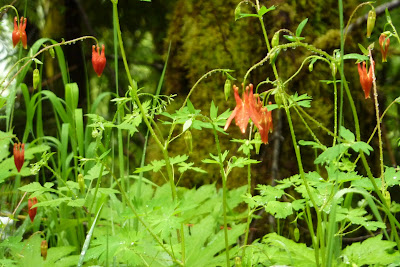
Thursday, May 27, 2010
Tuesday, May 4, 2010
All About Grouse
 Today I was working on one of the many steep hillsides around here, when I had to stop suddenly. I wasn't out of breath, but my heart had begun beating uncontrollably! It was totally silent in the woods, and I could hear each beat - bum bum bum bumbum bubububum! I had no idea what could be going on - maybe I had imagined it. I continued work, unsettled and slightly worried. But a few minutes later, it happened again! And then, again! When I put a finger to my pulse as I listened, I was even more confused. The beats seemed to match up, but in some ridiculous double-time. What could I be hearing? Then, it came to me - I was hearing a grouse beating somewhere far away in the forest. By some coincidence of the angles and hillsides, I couldn't place a direction on it and had the impression that it was something very close and quiet, rather than far away and loud. Heartbeat of the forest! I was aortically synced with a Ruffed Grouse, Bonasa umbellus.
Today I was working on one of the many steep hillsides around here, when I had to stop suddenly. I wasn't out of breath, but my heart had begun beating uncontrollably! It was totally silent in the woods, and I could hear each beat - bum bum bum bumbum bubububum! I had no idea what could be going on - maybe I had imagined it. I continued work, unsettled and slightly worried. But a few minutes later, it happened again! And then, again! When I put a finger to my pulse as I listened, I was even more confused. The beats seemed to match up, but in some ridiculous double-time. What could I be hearing? Then, it came to me - I was hearing a grouse beating somewhere far away in the forest. By some coincidence of the angles and hillsides, I couldn't place a direction on it and had the impression that it was something very close and quiet, rather than far away and loud. Heartbeat of the forest! I was aortically synced with a Ruffed Grouse, Bonasa umbellus.The male ruffed grouse beats his wings upon logs as part of a territorial display. Since it is early May, this male was probably looking for a mate. His ability to defend his log communicates his fitness, and therefore, his desirability as a mate, to females all over the area. Pictured here is a photograph of a female strutting along a road. Now, who wouldn't want to impress that lovely lady? She is looking perky because she doesn't know what to make of my truck.
According to the Cornell Lab of Ornithology website, allaboutbirds.net, both sexes of ruffed grouse mate with multiple partners, and the females raise young alone. The benefits to a male grouse are obvious; his genes are passed on to as many offspring as possible. But if one assumes a "normal", human model of mating biology (and why wouldn't one? We are, after all, humans!), then it is less obvious why a female bird would prefer to mate with many males. If the first male she mates with is most likely to fertilize her eggs, then what use are the rest of her mates?
It turns out that bird reproductive biology is rather different from mammalian reproductive biology. Many kinds of birds have evolved sperm storage tubules, which are basically holding tanks for sperm before they reach a female's egg. These tubules facilitate what is called passive sperm loss, in which sperm die at a constant rate over time. In fact, it is the last male she mates with who will receive the honor of fertilizing most of her eggs, since his sperm will be the most recent and thus, the most numerous. Of course, there are other factors which influence male success - the timing of mating relative to the development of the egg, and the viability and amount of each male's sperm.
It is still unclear how the female bird benefits from these multiple partnerships. Most research on the subject addresses species which pair-bond ("socially monogamous") and then copulate outside their pair-bond, not species in which females raise their young without paternal care, like grouse. Perhaps in socially monogamous species, a good caretaker male is not necessarily genetically desirable for a particular female. Thus, two males may be needed to play two different roles.
But for species like the grouse, all a female needs is a genetically desirable male - not a good caretaker, too. Perhaps behavioral studies will elucidate: if a female only mates with successively more desirable males, then her eggs will be fertilized by the latest, and thus, greatest, sperm she has found so far. Any previous matings retroactively become backup. However, I cannot find scientific literature discussing how, or if, female mate choice works in conjunction with sperm storage structures.
Who knew that bird sex was so complex? My eyes will be peeled for scientific developments in this area.
sources:
Peterson Field Guides: Western Birds.
Cornell Lab of Ornithology: Bird Songs of the Pacific Northwest (cd)
All About Birds: http://www.allaboutbirds.org/NetCommunity/Page.aspx?pid=1189
Northern Wilds: northernwilds.com
Birkhead, Tim R. Sperm Competition in Birds. 1998. Reviews of Reproduction 3, 123-129. (ror.reproduction-online.org/cgi/reprint/3/2/123.pdf)
Subscribe to:
Comments (Atom)


